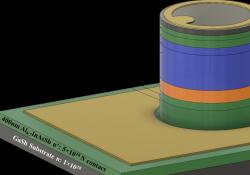Light Detection and Ranging (LiDAR) is an important technology for collecting data about the world around us and serves as a backbone for the push for self-driving cars. As it becomes ubiquitous across industries, the race is on to improve this technology.
A team of researchers from the Cockrell School of Engineering at The University of Texas at Austin and the University of Virginia have developed a new avalanche photodiode, a type of detector, that could take LiDAR tech to the next level. It reduces the noise created by LiDAR systems, makes the lasers they use safer for the human eye and reduces the need for excess cooling during operations. The discovery has the potential to transform next-generation LiDAR technology and night-vision imaging by enabling higher-power operation with fewer impacts.
The team is now working with researchers at Lockheed Martin, led by Cockrell School alumnus Rodolfo Salas (Ph.D. Electrical and Computer Engineering 2015), to scale up the technology.
Many LiDAR applications, including robotics, autonomous vehicles, wide-area surveillance and terrain mapping require high-resolution sensors that can detect weak signals reflected from distant objects. Eye safety has limited the adoption of these LiDAR systems, however, because the requisite higher laser power poses an increased risk of eye damage.
“The 2-micrometer window is ideal for LiDAR systems because it is considered eye-safe and has the right detection reach,” said Joe Campbell, a professor of electrical and computer engineering at the University of Virginia. “I can envision our avalanche photodiode impacting numerous key technologies that benefit from high-sensitivity detectors.”
The team’s findings were published in May in Nature Photonics. The team includes UT’s Seth R. Bank, a professor in the Cockrell School’s Department of Electrical and Computing Engineering, UT electrical and computer engineering Ph.D. student Stephen March, and, from UVA, Campbell and postdoc Andrew Jones. The U.S. Defense Advanced Research Projects Agency (DARPA) and the Army Research Office funded the project.
The team created a digital alloy out of aluminum, indium, arsenic and antimony at Bank’s Laboratory for Advanced Semiconductor Epitaxy at UT. The alloy combines long-wavelength sensitivity, ultra-low noise and the design flexibility that is needed to achieve low dark currents, an important dynamic not available with existing low-noise avalanche photodiode tech.
“Our ability to control the crystal growth process down to the single atom-scale enables us to synthesize crystals that are forbidden in nature, as well as design them to simultaneously possess the ideal combination of fundamental material properties necessary for efficient photodetection,” Bank said.
Future work will concentrate on achieving low-noise operation at near-room temperatures, extending the operating wavelengths further into the infrared, and pushing the sensitivity to the single photon level.



